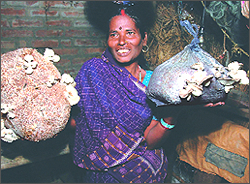From India to South America. If you want to see how one farm has diversified into mushroom production, our friend Andy Jarvis has posted a set of informative photographs to flickr, the image sharing web site.
Mushrooming success
 Sometimes it is hard to keep up with the pace of news. A week ago The Indian Express ran a story about Lal Muni Devi, a poor landless woman who had made a great success of turning wheat waste into mushrooms. Lal Muni had not even heard of mushrooms four years ago. Researchers from the Indian Institute for Agricultural Research turned up and trained 25 women from her village to grow mushrooms, and she was one of the most successful. Reason enough to report. But the reason The Indian Times seems to have published the story now is that Lal Muni Devi featured in a news story from CIMMYT, the International Centre for the Improvement of Maize and Wheat, more than a year ago! No matter, it is always good to read about successes in diversifying species to boost incomes.
Sometimes it is hard to keep up with the pace of news. A week ago The Indian Express ran a story about Lal Muni Devi, a poor landless woman who had made a great success of turning wheat waste into mushrooms. Lal Muni had not even heard of mushrooms four years ago. Researchers from the Indian Institute for Agricultural Research turned up and trained 25 women from her village to grow mushrooms, and she was one of the most successful. Reason enough to report. But the reason The Indian Times seems to have published the story now is that Lal Muni Devi featured in a news story from CIMMYT, the International Centre for the Improvement of Maize and Wheat, more than a year ago! No matter, it is always good to read about successes in diversifying species to boost incomes.
Photo by Paras Nath from The Indian Express
Mapping underutilized genomes
It seems you can hardly open a newspaper these days — or open a news website — without reading that someone somewhere has mapped yet another genome, whether human, Neanderthal, sheep, mouse or bee. It hasn’t received any press coverage at all, but the taro (Colocasia esculenta) genome has now been added to the list. CIRAD scientists working in Vanuatu, in the South Pacific, and others just announced this at the recent meeting of the International Society for Tropical Root Crops held in Kerala, India.
One thing to note is that these are not all really genome mapping projects. Despite the many headlines to that effect, scientists are not mapping the Neanderthal genome. What they’re doing is sequencing it — or a small bit of it. There is a difference.
Sequencing means determining the (correct!) order of all the DNA bases — the letters of the genetic code — of an organism. Besides some very fancy hardware and software, you need the DNA of just one individual to do this. Mapping is both rather less and rather more.
Less, because it only aims to determine the relative location of some major landmarks of the genome. That is, not the order of all the letters in the book of life, but rather the relative positions of the pages where some choice quotations can be found.
More, because some of those genomic landmarks may be close to genes associated with predisposition to a disease or some other interesting trait. To find that out you need DNA from whole families, or populations, rather than a single individual — in the case of taro, the family was all the progeny from a couple of crosses between local ni-Vanuatu varieties. You trace the inheritance of the trait you’re interested in together with that of specific “markers” (any observable variation in the DNA sequence), and, hey presto, if you’re lucky you have a much more readily documented proxy for the trait.
With the new genome map, we now have genetic proxies for things like the yield and dimensions of the underground corm of taro. This edible aroid is an important staple in Oceania and parts of South and South East Asia, Africa and the Caribbean, but there are few breeding programmes around the world, which is why it often ends up on lists of so-called “neglected and underutilized species.” This map should make it easier to screen the hundreds of seeds that can result from crossing two varieties and select only the best individuals for further testing (this is called marker-assisted selection). It should therefore stimulate people to set up taro improvement programmes.
These are much needed. Mainly vegetatively propagated by farmers, taro is genetically fairly uniform in many places, making it susceptible to pests and diseases. It was almost wiped out in the South Pacific country of Samoa in the mid-1990s by taro leaf blight, a fungal disease. It has recovered at least in part because a regional project (called TaroGen) was set up by Pacific countries with support from Australia to breed — in collaboration with farmers — and disseminate resistant varieties.
Biotechnology means GMOs to many people, but this is a case where biotechnology is facilitating conventional breeding — nothing to do with genetic engineering. It may not have made the news like other mapping projects, but the new genome map means taro breeding should prove a little bit easier in the future.
Swiss cows to go cold turkey
So apparently Swiss farmers will no longer be able to feed cannabis to their cows. Bummer.
Horticulture and the city
There’s a great feature in the latest New Agriculturist on urban horticulture, with stories ranging from growing food in buckets in Lima to grafting tomatoes on eggplant roots in Vietnam to producing jasmine in the Philippines.